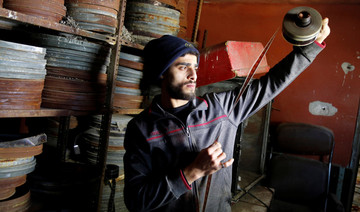KAMPONG CHAM, Cambodia: On the Chinese messaging service WeChat, Ol En scrolled back through time. Call unanswered. Call unanswered. Call declined.
The last she’d heard from her teenage daughter was a voice message on Feb. 10. “Mum — they don’t give me a penny. They just keep me in the house. Maybe things will change when I give them a baby,” it said.
Sitting stonefaced in her one-room shack in rural Cambodia, chickens clucking and wind kicking up red dust, the mother of ethree recalled how her first-born was trapped in China.
“She escaped once and the brokers almost beat her to death,” En said. “If she dares to run again, there are no guarantees.”
The 16-year-old is one of thousands of Cambodians fallen prey to criminal matchmakers who scour the poorest pockets of Southeast Asia for young brides to send to China.
Some 40 million men in China will need to look abroad for a wife by 2020, according to the Chinese Academy of Social Sciences think tank — the legacy of Beijing’s one-child policy, which has seen families abort female fetuses for decades.
Hundreds of thousands of women from Cambodia, Laos, Vietnam and Myanmar have gone to China to wed, activists say. Some end up happily married; others speak of violence and forced labor.
With few employment avenues for young women and ballooning debt levels, rural Cambodian families make soft targets for brokers who ensnare the relatives of potential brides in their schemes, blurring the lines between victims and accomplices.
The matchmakers are near impossible to track down, police say, hiding behind nicknames and throwaway “burner” phones while employing a network of local elders to coax young women out of the village by offering huge sums of cash to their families.
In En’s case, it was a neighbor — and distant relative — who paved the way to China.
She received $2,100 in cash, and promises that her daughter would find love, work and wealth in China to funnel back to debtors threatening to repossess her house and land.
But it was all a ruse. The girl was sold, then held as a sex slave and servant by a man she had never met.
“Day and night, he demands sex from her,” En said.
“I cannot live in peace — the one who sent her lives freely in this village but my daughter is lost in China.”
BOUNTIES
Thol Meng has been working to stop human trafficking for 16 years, now as deputy chief of a specialized police bureau in Kampong Cham province — one of the nation’s hardest-hit regions.
He has seen waves of Cambodians being tricked, from men sold on to Thai fishing boats to women held as domestic slaves in Malaysia. But “brides to China” is the biggest concern, he said.
“A few years ago, it was about $500 for one girl,” he said. “Now families can get up to $3,000.”
Prices have skyrocketed along with rising awareness of the dangers and penalties for human trafficking.
But in a country where the average annual income is $1,200, the bounties on offer prove hard to turn down.
“Human trafficking starts with the parents,” Meng said. “The mothers control everything ... (they) receive the benefits.”
“In fact, we can say that they sell their daughters.”
While the mothers are culpable, they are victims, too, according to Meng — preyed upon by sophisticated networks running a criminal enterprise worth millions of dollars.
“We mostly arrest the small fish, the locals. The big fish cut off communication, leaving the locals with no details.”
As such, trafficking stories in the media often feature photos of police apprehending middle-aged women wearing pyjamas.
A Cambodian ‘bride’ in China made a fresh cry for help every other day in 2018, said five charities working to end the trade.
Helping them escape is another matter. Most victims do not know their whereabouts in China, cannot read or speak the local language, and have limited access to phones and Internet.
“Without an address, it is almost impossible to help,” said Teng Seng Han, a monitor with the Cambodian Human Rights and Development Association, which works to repatriate ‘brides’.
Those who make it home — some with stories of being raped by multiple men or being sold from one house to another — rarely go to the police, as immediate relatives are usually complicit.
Kompong Cham had four trafficking convictions last year — down from 20 in 2015 — despite the demand for Cambodian brides in China “rising sharply” in recent years, according to Meng.
Outstanding loans, Seng Han said, are the main reason families send their daughters to China — and brokers know this.
“The brokers look for people who are in debt. First they try to convince the daughters, and then they influence the mothers,” he said. “It’s always about money.”
In 2016, the Cambodian government said 6,900 undocumented women had been identified in China. The real number ensnared by the bride trade could easily be double that, campaigners say.
NO REMORSE
In rural Cambodia, the demand for ‘brides’ in China is tearing apart families — and not just those of the victims.
Sim Chhom used to spend his waking hours laboring on building sites in town. He would earn $6 on a good day.
Now he spends his time looking after his children and the child of his oldest daughter, who is happily married in China.
“I have no time to go to work,” he said, looking frail and ill. “So I just stay here and catch fish to feed my family.”
His wife, Chhieng Ly, was arrested in May and charged under human trafficking laws for assisting a relative who had heard of the good life in China and wanted to send their daughter.
“I have not seen my children since I was arrested,” Ly told the Thomson Reuters Foundation in an interview at the provincial prison. “I only shared a phone number — is that so wrong?“
While Ly has seven years to lament her decision, the woman who helped En’s teenage daughter reach China shows no remorse.
Phorn Sokneng went to China in 2016 and married a 44-year-old farmer — twice her age — who she said treats her well.
The following year, during a visit home to Cambodia, she was approached by En’s mother, who was desperate for fast money.
Sokneng helped En’s daughter move to China, she said, but relations turned sour when En filed a complaint with Cambodian police after realizing her daughter’s fate.
The next time Sokneng returned to Cambodia, in September, she was arrested and charged under human trafficking laws.
“I feel like I am the victim — I helped them and now I am in trouble,” the bride-turned-broker said, sitting next to her mother just a few hundred meters from En’s house.
Free on bail ahead of an October court date, Sokneng said she had nothing to say to En, her cousin by marriage.
“I have not been to talk to them,” she said of En’s family.
“Why would I? They are the ones who filed the complaint that will send me to prison.”























